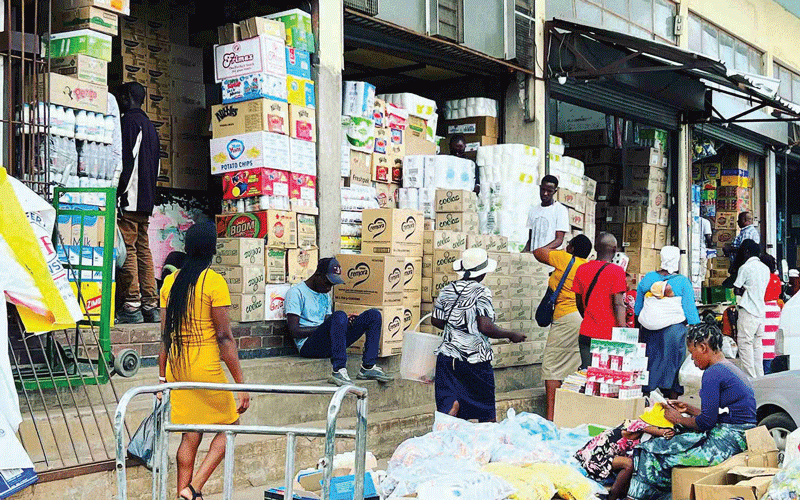
IN recent years, particularly after the re-introduction of the local currency in February 2019, informal trade has grown at quite an exponential rate in Zimbabwe.
Walking in downtown Harare, one cannot be oblivious to the high volumes of human traffic going in and out of small, tightly packed convenience stores which are mainly concentrated in downtown Harare.
Assortments of household grocery items lie shelved on every available wall space in these tiny outlets, which have come to be popularly known as “tuck shops”. Over the last few weeks, a raging debate has ensued on multiple fora about the impact, or lack thereof, of these tuck shops on the economy, especially on formal trade.

It is crucial to understand the nature of these informal convenience stores and how they arose. While tuck shops have existed in the economy since time immemorial, lately they have risen in popularity largely due to two main factors which affect their demand and supply dynamics.
Firstly, due to the rising cost of living and the continued erosion of disposable income, Zimbabwean consumers have become more critically aware of every expenditure that they make and the need to make the most out of every cent in their purses.
The Covid-19 pandemic came with a lot of lessons, one of which was that your source of income tomorrow is never guaranteed. In these tough times, consumers now place more emphasis on the product experience rather than the shopping experience, which makes consumers largely indifferent to the environment in which they purchase the products.
Secondly, and most importantly, there exists an arguably high premium between the official and the parallel market exchange rates. This, when coupled with the tight enforcement of pricing that is in tandem with official rates in the formal retail sector by the relevant authorities, reduces the ability of the formal sector to price competitively.
To illustrate, consider a product that costs ZW$7 000 to purchase from a manufacturer when the official rate is at ZW$6 100 to the United States dollar and the parallel at ZW$7 200 (an 18% premium). Ignoring any effects of trading margins, the informal trader will purchase the product from the manufacturer by transferring ZW$7 000 and then use the parallel rate as a basis to come up with a listed price of US$0,97 in their shops.
- Ex-ChiTown official jailed for bribery
- Poverty levels in record rise
- Online presence will help market Zim agric produce
- Online visibility will make it easy to market Zim’s produce
Keep Reading
The formal retailer, in compliance with the laws of the land, is compelled to use the official interbank rate in coming up with a listed price of US$1,15.
This results in the formal retailer’s price being 18% dearer to the consumer who simply assesses the US dollar listed prices as a basis for the purchasing decisions.
Note well that the 18% premium on the exchange rates is what has then translated into an equal 18% higher formal retail price. We then end up with multitudes flocking the tiny outlets in search of “cheaper” goods which assists the tuck shops in pushing volumes at small margins.
That explains the demand dynamics of how tuck shops have thrived by explaining how consumers are being drawn to them. However, it is not just consumers that are enticed to trading with these informal traders.
In these last few years, a rising number of manufacturers have also been attracted to the idea of pushing higher volumes of products to informal and general traders. This is largely due to the distinct ability by these informal and general traders to pay cash upfront and mostly in foreign currency to the manufacturers. This allows the manufacturers to quickly purchase raw materials, some of which are imported and can only be paid for in foreign currency.
This has recently become a significant pull factor as manufacturers, who had advanced local currency credit to formal retailers, were left counting heavy losses between May and June 2023 when the Zimdollar went on a free-fall and wiped away value from the trade receivables balances on the producers’ balance sheets.
Due to the diminishing inflow of consumers into retail stores as explained before, products take longer to sell, which results in retailers sometimes taking longer than usual to settle their dues to the manufacturers.
Some manufacturers also realise some notable cost savings and convenience in pushing products through the informal and general traders as they usually arrange their own transportation for collection of products straight from the manufacturers’ factories.
In contrast, formal retailers usually require that the manufacturer delivers its products to their retail stores around the country. There are also very few after-sales-services costs for a manufacturer for products they sell to informal traders.
Generally, cases of product returns and claims are very low for sales made to informal traders when compared to formal retailers. Explanations in this article have so far highlighted the consumer and producer forces supporting the flourishing of tuck shops.
However, there is another very notable factor to consider which is pivotal to how tuck shops and all other informal sector players thrive — the legal and regulatory environment in which they operate.
It can be argued that tuck shops are largely operating unabated and under minimum regulatory scrutiny relative to how operations of formal retailers fall under the microscope of authorities.
The procurement process of some tuck shops involves bringing in goods, mostly from South Africa, that evade the relevant import tariffs.
Further, with South Africa being a generally lower cost-of-production economy coupled with the rand’s weakening in recent months, these imported products are bound to make it to downtown Harare at a cheaper cost.
Due to the informal nature of their operations, many sales transactions in tuck shops occur without any receipt/invoice being issued which proliferates the growth of this shadow economy. Formal retailers are pressed to meet the minimum wage requirements of their respective National Employment Councils for their employees.
This requirement is not extended to informal traders who operate with a very loose, unregulated structure. Based solely on an analysis of the legal and regulatory environments and the level of enforcement, it is evident that the tuck shops have a distinct operating advantage in this regard.
Discernibly, there are also some clear advantages that formal retailers have over tuck shops. Access to capital and economies of scale are the two main trump cards they have over informal traders.
However, the high cost of borrowing in Zimbabwe adds on to the cost of doing business for a formal retailer, who heavily depends on debt for financing their operations.
Without an equally regulated informal sector, tuck shops will continue to gain mileage over the formal retail sector. It is imperative that all industry players have a re-evaluation of their operating models in light of these changes that have occurred and quickly evolve appropriately to ensure they continue to sail above the waters.
Formal retailers need to re-think their capital expenditure/store refurbishment priorities in light of the consumers’ shift towards placing higher value on product experience over shopping experience. Formal retailers must also re-think their margins, pricing strategies and payment terms in order to woo manufacturers back to the modern trade channel.
Equally important is that manufacturers must take heed that the tuck shops channel, which could be lucrative today for a producer, may not be as enticing tomorrow due to the fluid nature of the economic and regulatory environment.
As a result, a manufacturer should never burn bridges with the formal retail channel.
While industry players continue to engage the authorities to instil a level playing field and create a more conducive business environment for all, it is only those agile enough to quickly adapt and re-invent their operations in these circumstances that will survive this brutal test of time.
- Mukosi is a chartered accountant and a member of the Institute of Chartered Accountants of Zimbabwe. He did his articles with one of the “Big Four” audit and accounting firms and is a finance and corporate strategy professional with considerable experience in the FMCG sector. He writes in his personal capacity.






